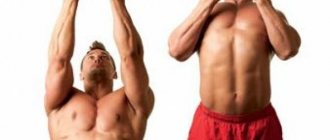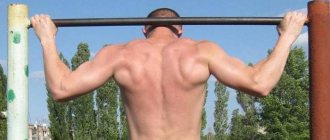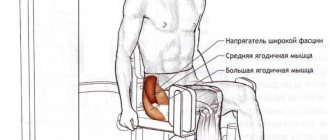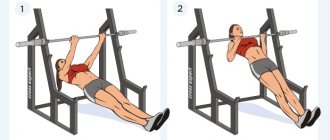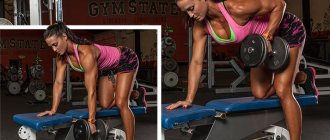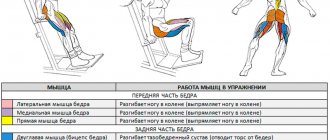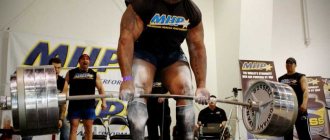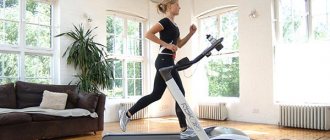How does this type of pull-up differ from others? Its advantages and implementation technique. Working muscle groups. The horizontal bar is a popular piece of equipment in the world of sports that opens up new perspectives for beginning athletes and helps in working out many muscle groups. One of the exercise options is wide-grip pull-ups, which are aimed at working the latissimus dorsi muscles.
The exercise belongs to the basic category. Regular training guarantees a V-shaped back, which so adorns the torso of a real man. What are the features of this exercise? What muscle groups is it aimed at working? What implementation nuances should be taken into account?
Performance technique
To achieve maximum results, wide-grip pull-ups must be performed with strict adherence to technique. The algorithm of actions is as follows:
- Grab the horizontal bar at a distance wider than your shoulders by 20-25 cm or more .
- To maximize the stretch of the lats, don't put any weight on your arms—your back should do all the work. Many athletes recommend imagining that your arms are ropes that only hold the torso, and other muscle groups take on the rest of the load.
- As you exhale, tense your muscles and reach towards your chest. During the entire period of pulling up, watch your elbow joints - they should be in the same position. It is forbidden to pull them to the sides of the body.
- Raise your torso until your chest is level with the bar or slightly below it.
- Inhale and lower yourself to the starting position.
How to pump up a group of pectoral muscles on a regular horizontal bar?
Pull-ups are the same vertical row, but here it’s not the handle that comes towards us, but we pull ourselves up to the horizontal bar. And the basic rule is that the load vector must pass through the chest. Not along, but through the chest. How to achieve this?
A mental principle can help you. Someone mentally reaches for the horizontal bar, that is, tries to pull their body towards the crossbar, while someone mentally pulls the horizontal bar towards themselves. If you imagine, hanging on the horizontal bar, these two moments in turn, then you will notice a difference in the actual mood for pulling up. This method helps to set up the correct motivation of the nervous system to perform the exercise. Therefore, you need to choose your own way of imagining what exactly you are doing, pulling yourself up to the horizontal bar or pulling the horizontal bar towards you.
Pull yourself up energetically and powerfully, bending your arms, until your chin is just above the level of the bar. Pause for a moment in this position, feel how the shoulder blades come together and the latissimus muscles contract. Then lower yourself smoothly, but don't relax at the bottom. Don't go too low or pause between pull-ups. Pull yourself up again immediately. And so on.
Pull-ups on the horizontal bar with a wide grip. Start.
Pull up continuously throughout the entire approach. Complete the required number of repetitions. If you can complete 12-15 repetitions in a set, you can safely attach additional weight to your belt.
Wide-grip pull-ups perfectly develop not only the latissimus dorsi muscles, but also the biceps, forearms, posterior deltoid muscles, serratus muscles, and trapezius muscles. Significantly increases grip strength.
This is one of the basic exercises for pumping up the upper shoulder girdle. It has both positive and negative aspects of regular use.
There are a large number of subtleties and nuances of performing this exercise that allow you to achieve its maximum effectiveness. These same nuances can either increase or decrease the load on the muscles being trained.
The effectiveness of exercises largely depends on the correctness of their implementation. Pull-ups are no exception. Let's look at the rules that apply to each type.
- pull-ups are performed using muscle strength, without inertia and body swaying
- lifting is carried out without jerking
- The chin at the top of the lift should be above the bar
- the descent is smooth, equal in time to the ascent
- correct breathing: exhale on the way up, inhale on the way down
- strong grip
- vertical position of the body
- The starting position for all types of pull-ups (except for pull-ups with a wide grip behind the head) is hanging, bending in the back, legs bent at the knees and crossed
Pulling your chest to the bar is a very effective exercise. To get maximum training results, all movements need to be worked out very quickly. The technique for performing the Chest To Bar Pull-up exercise is as follows:
- Jump onto the bar. The grip should not be very wide, slightly wider than shoulder width.
- Keep your torso straight and, using the swing of your legs and whole body, pull your chest up towards the bar.
- Do maximum reps.
Despite the fact that the target load on the back and triceps muscles is less than in conventional pull-ups, the athlete’s joints and tendons are actively involved in this exercise, so warm up very well before training to avoid injuring them.
Since CrossFit is considered an intense type of training, this particular option for performing pull-ups is considered more suitable. Thanks to specific jerking movements, the athlete can perform large numbers of repetitions much faster. At international crossfit competitions, many athletes do pull-ups this way.
Despite several positive aspects, the Chest To Bar Pull-up exercise should not be performed by beginner athletes who do not yet know how to do a normal pull-up in a standard way. This can put a beginner at risk of injury.
The simplest type of simulator is considered to be a horizontal bar, on which ancient Greek soldiers trained. It helps strengthen muscles. Of course, if you stop only at pull-ups, it is unlikely that you can qualitatively develop the muscles on the chest.
Exercises on the horizontal bar are considered an excellent addition to the main training for the chest muscles. The dorsal and pectoral muscle fibers are considered to be opposing. When pulling up, all movements made must be smooth. Steady breathing helps you achieve success from your workouts.
It is important to control the load. It is forbidden to perform many repetitions in one approach. It is best to focus on the quality rather than the quantity of exercises. An increase in the number of repetitions is allowed with ideal technique. After adaptation, the muscles need additional “stress” in the form of increased repetitions.
When performing exercises, you need to correctly change the type of grip: wide, narrow, medium. The load on the muscle group depends on this. A narrow grip only increases the load. At first, 3 full approaches of 15 pull-ups will be enough for training.
What muscles work?
Wide-grip pull-ups include the following groups:
- The main muscles worked are the latissimus, rhomboid and teres major dorsi muscles . Each of them has an individual purpose. Thus, the latissimus muscle pulls the back up and helps press or abduct the elbows to the sides. Diamond-shaped - promotes downward rotation of the scapula (with the lower edge close to the vertebra). The large round brings the torso to the elbow joints and abducts the shoulders.
- A number of auxiliary muscle groups also take part in the work. Among them are the pectoralis major and minor muscles, biceps, triceps, subscapularis and coracobrachialis muscles.
Wide grip pull-ups: options
- Wide grip pull-ups basic version
- Wide Grip Head Raises
- Weighted pull-ups
- Reverse grip pull-ups
Wide grip raises basic version: video
Wide grip pull-ups
Wide grip pull-ups
Differences
- Reduces the load on the latissimus muscles. Places more stress on the upper and middle back.
- Requires good flexibility of the shoulder joints. If performed frequently, this exercise can lead to shoulder injuries.
Weighted pull-ups
Weighted pull-ups
It differs from the basic version only in the additional weight.
Suitable for advanced athletes. Good for training strength and mass.
Reverse grip wide pull-ups
Reverse grip wide pull-ups
What rules to consider when performing the exercise?
During the pull-up process, consider a number of the following recommendations:
- Do not involve the forearms and biceps brachii muscles in the work. Imagine that your arms simply hold the weight of your body, and instead of hands (conditionally) there are hooks. The task of the remaining muscle groups is to lift the body to the bar.
- The wider the arms are spread when performing the exercise, the more actively the latissimus muscles are loaded and the more actively the back develops. The main thing is not to overdo it. The criterion that you should focus on when choosing a position is ease of execution.
- At the top point, the chin should extend above the horizontal bar. It is important that the elbows are not brought towards the torso. If you make such a mistake, the amplitude of torso movement decreases. The result is a decrease in the effectiveness of the exercise.
- If the latissimus muscles are underdeveloped, pull-ups cause a number of difficulties. Beginners have two options - ask a partner to help with the exercise (he will lift the body until the chin reaches the required point). The second option is to consider other types of pull-ups and incorporate them into your training program. In the future, when the back muscles become stronger, it will be easier to return to performing this type of exercise. A good option is pull-ups on the bar with an underhand grip (usually easier due to the involvement of the biceps in the work). It is worth adding vertical rows on a block to your training program.
- You can use different breathing techniques. So, you need to take in air in the negative phase, and release it during the load. On the last repetitions, while resting in the starting position, you are allowed to take a few additional breaths.
- Try not to jerk and work only using your back muscles.
Wide grip pull-ups: technique
- Hang from the horizontal bar. Use a wide grip. Arms straight. Swinging is not allowed.
- Take a breath. Pull up until your chin is above the bar.
- Secure your body. Lower yourself to the starting position until your arms are straightened.
Application of the exercise
To whom . Athletes of intermediate level and above. For girls and beginners, it should be performed in a gravitron or with an elastic band.
When . Pull-ups are performed at the beginning of a back workout.
How many . The exercise should be performed for 3-4 sets with a maximum of 20 repetitions. Rest time between sets is 2 minutes.
Load on target muscles on a 10-point scale
| Latissimus muscles | 8 (high) |
| Upper back | 7 (high) |
| Forearms | 5 (average) |
| Biceps | 4 (average) |
| Shoulders | 3 (weak) |
| Triceps | 2 (weak) |
| Type of exercise | Basic |
| Total load | 29 (high) |
Adviсe
- To increase the load on the latissimus dorsi muscles, the exercise should be performed with a shortened range of motion. The arms in the initial (starting) position should be slightly bent.
- As you lift, stretch your elbows out to your sides. Imagine that you are pushing your elbows back and down. In this case, the target back muscles will be loaded, and the arms, on the contrary, will be unloaded.
Errors
- Rocking. The exercise should be performed by lifting the body vertically up and lowering vertically down.
- Jerks, sudden movements and stops. For safety and to increase efficiency, movements should be performed smoothly and without stopping in the starting position.
There are a huge number of pull-ups. Let's look at all the options for pulling up on a bar with a wide grip. How do they differ from each other?
General provisions
To understand the principles of the exercise, it is worth understanding each of its aspects:
- Who is it suitable for ? This type of pull-up is suitable for both beginners and professionals. Its advantage is that a large number of muscles are involved in the work (the exercise is considered basic).
- When to do it ? The best time to perform this is at the beginning of a workout aimed at working the back muscles. Once completed, move on to other exercises such as bent-over rows, front rows, T-bar rows, etc. In some cases, it is possible to perform pull-ups after deadlifts. The advantage of this alternation is the ability to stretch the spine.
- How much to do ? The total number of repetitions is 12-15 times, the number of approaches is 3-4.
- How to increase efficiency ? Over time, your own weight becomes small. In such a situation, add additional weight. The load is fixed on the belt. It is permissible to use wrist straps that securely secure the hands.
How to create a training program with pull-ups?
Pull-ups can be performed not only on the back. It is best to combine different types of exercise in one workout. Vary your grip width and intensity of movements.
Athletes who work out in the gym should do pull-ups while pumping their back. It is best to perform this sports element at the beginning of training. Also during the lesson you can do rows of a sports equipment to the belt or rows of a horizontal and vertical block. Warm up well before doing pull-ups. You can wear special gloves on your hands. Perform 10-12 reps for 4 sets.
Determine the main goal of the lesson. To work out the relief, you can do the maximum number of repetitions per approach. To increase muscle mass, exercise with weights. To do this, you can put a briefcase with a load on your shoulders, and also attach a barbell weight to your belt.
If you do not have the opportunity to exercise with heavy sports equipment, try to constantly change the width of your grip. Exercise with a narrow position of the arms will contribute to the development of the biceps. You can also turn your elbows slightly to the side.
Wide-grip pull-ups should be a key part of any back workout. After some time, you will notice serious changes in your figure. Strength indicators in other exercises will increase several times.
A workout program for beginners will help develop strength indicators.
Alternative
Experienced athletes do not recommend stopping only at the exercise discussed above. Today, other types of pull-ups on the horizontal bar are also popular, and they are no less effective:
- Medium grip (palms facing away) . This option is called classic. It is popular in school, the army and among most novice athletes. The main emphasis is on the back, the flexor muscles of the forearm, and the biceps brachii muscle.
- Medium grip (palms facing you) . Compared to the previous version, this type of exercise is easier. The main difference is that here the biceps receive more load.
- Narrow grip (palms facing each other) . This option is good for people who have wrist problems. When performing, the lower part of the latissimus muscles is worked out.
Exercise technique
To ensure that your workouts proceed correctly and without injury, adhere to the principles of performing this exercise:
- keep your body tense, do not sway back and forth or from side to side;
- do not change the position of the body and forearms, fix them at the same angle;
- your elbows should always be exactly under the horizontal bar line;
- lower from the top point smoothly and extend your arms as much as possible in order to load the deltoids and trapezius as much as possible;
- start exercises with a minimum number of repetitions, do not use weights until you learn to do at least fifteen repetitions in one approach;
- lift yourself to the bar as you inhale, and lower yourself as you exhale.
Muscles involved
Pull-ups even work muscle groups that are not directly involved in the workout, such as the thigh muscles. When performing this exercise, the deep groups of the press are pumped, and its superficial groups are also developed during the training process.
Did you know? The world record for quantitative pull-ups was set in the 1990s by South Korean Shin Yong. He performed 612 pull-ups in one set. At that time, the record holder was 70 years old. This record has not been broken by anyone to this day.
This is especially true for the pectoral muscles involved in pulling up, which are responsible for the safety of the lungs and heart. These exercises affect the volume of muscle mass in the arms, such as the triceps and biceps. They are needed to strengthen the back muscles: trapezius, round, latissimus.
- Back. We’ll talk more about all the loaded back muscles below.
- Biceps. To actively pump up this muscle group, you need to perform pull-ups with a reverse grip, while keeping your hands shoulder-width apart.
- The triceps are trained with exercises on the bar, when you do pull-ups with a very narrow grip.
- Brachioradialis muscle group of the forearm. These muscles develop with any grip, as they depend on the load on the hands.
Only with a simple bar will you be able to work almost all the muscles of the upper body. It also depends on the way you perform the exercise. Pull-ups involve the work of the elbow and shoulder joints, so it can be classified as a basic exercise.
The following areas swing on the horizontal bar:
- Latissimus dorsi muscles;
- Trapezoid;
- Triceps and biceps;
- Deltoid;
- Forearms;
- Abdominal muscles (rectus, oblique and transverse).
As you can see, this exercise should be performed not only for the sake of “wings”. Just holding onto the horizontal bar engages and strengthens many muscles throughout the body. But you can focus on one or another area by changing the pull-up method.
In addition, frequent training with the bar will develop a strong grip and fingers. Over time, the skin of the palms will adapt and become rougher. Thanks to this, it will become much easier for you to perform the exercise compared to the first days.
You can do pull-ups in a variety of ways, both with a wide regular grip and a medium reverse grip. Each variation will include different fibers, but the major muscle groups remain the same. When doing pull-ups, the latissimus dorsi, rhomboid, teres major, and trapezius muscles are subjected to heavy loads. The biceps brachii, brachialis and brachioradialis muscles also help to pull the body towards the bar.
To learn how to do pull-ups on the horizontal bar, perform lifting exercises that involve the same muscles.
The main benefit of pull-ups is that they allow you to work almost all the major muscles of the shoulders and back:
- back muscles (latissimus, trapezius, rhomboids, teres)
- breasts (major and minor pectorals)
- serratus anterior muscles
- shoulder muscles (biceps, brachialis, triceps, rear deltoid) and forearm
- the press performs static work to fix the vertical position of the body
The main feature of exercises on the crossbar is that during these exercises almost all the muscles of the human body will work. However, if you want to train a specific muscle group, first you will have to decide on the answer to the question: “which grip pattern is best in your case?”
After all, with the help of various exercises, you can focus the largest share of the load on those muscle groups that we are going to pump today.
- Biceps. To actively pump them up, push-ups on the horizontal bar should be performed with a reverse grip with a sufficiently large distance between the hands. In this case, you and I will train them.
- Forearm muscles. They work great together with the biceps when performing reverse grip pull-ups.
- Triceps. To train them, you should perform exercises on the horizontal bar with a narrow grip.
- Flexors, extensors of the forearms. The elbow and wrist area contains a large number of different muscles. These include: flexors and extensors of the fingers, brachioradialis muscles (they are used to flex the arms at the elbows), pronators (responsible for turning the palms down) and supinators (responsible for turning the palms up). All of these muscles will be trained during any push-up on the bar.
